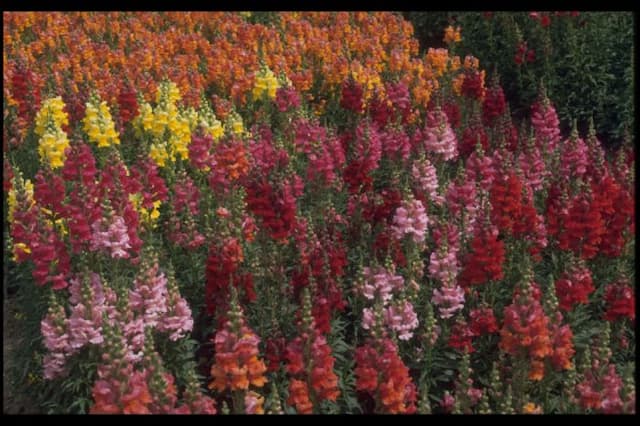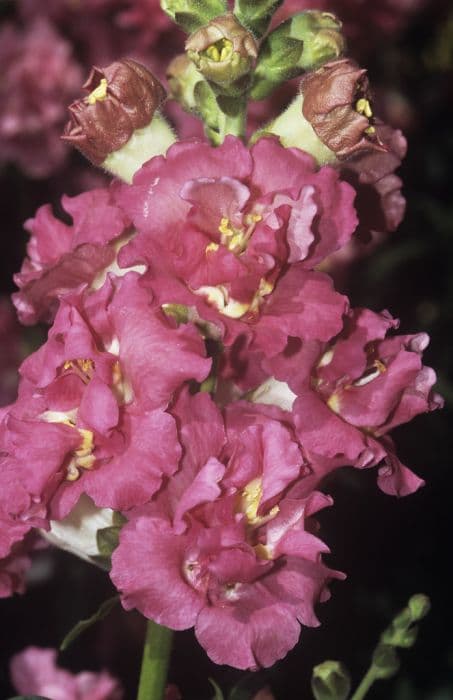Smallflower penstemon Penstemon procerus 'Roy Davidson'

ABOUT
Known as Small Penstemon or Dwarf Penstemon, Penstemon procerus 'Roy Davidson' presents a picturesque appearance. This plant typically showcases a mounding or sometimes spreading habit, with dark green, lance-shaped foliage that provides a lush backdrop for the flowers. The blooms of the Small Penstemon take center stage when in season. Each flower consists of a small, tubular shape that flares at the mouth into lobes. The colors range from a soft lavender to a more profound purple-blue hue, often with a paler throat that may display fine, delicate stripes or spots. These captivating flowers are arranged in tall, slender spires that rise elegantly above the foliage, creating a striking contrast in texture and color. The blossoms are frequented by a variety of pollinators, adding to the dynamic display of the plant in its blooming period. Overall, Small Penstemon 'Roy Davidson' possesses an alluring charm, with its combination of fine foliage and the graceful poise of the flowering spikes, lending itself well to rock gardens, borders, and wildflower meadows where their delightful flowers can be appreciated up close.
About this plant
 Names
NamesSynonyms
Small-Flowered Penstemon, Davidson's Penstemon, Tiny Blooms Penstemon
Common names
Penstemon procerus 'Roy Davidson'.
 Toxicity
ToxicityTo humans
The plant commonly known as Small-flowered Penstemon is not known to be toxic to humans. There are no well-documented cases of poisoning from ingesting Small-flowered Penstemon. However, it is generally advised to avoid ingesting plants that are not known to be edible to prevent any potential adverse effects.
To pets
Small-flowered Penstemon is also not known to be toxic to pets. There is no significant evidence to suggest that this plant poses a toxicity risk for domestic animals. However, as with humans, it is often best to prevent pets from ingesting plants that are not specifically intended for consumption to avoid any unforeseen complications or digestive issues.
 Characteristics
CharacteristicsLife cycle
Perennials
Foliage type
Deciduous
Color of leaves
Green
Flower color
Blue
Height
1-2 feet (30-60 cm)
Spread
1 foot (30 cm)
Plant type
Herb
Hardiness zones
3
Native area
North America
Benefits
 General Benefits
General Benefits- Attracts pollinators: This species is known for attracting bees and butterflies, which are essential for pollination.
- Drought tolerant: Once established, it requires minimal watering and can survive in dry conditions, making it suitable for xeriscaping.
- Low maintenance: Penstemon procerus 'Roy Davidson' does not require frequent fertilization or pruning, making it easy to care for.
- Cold hardy: It is capable of withstanding cold temperatures, making it suitable for planting in a variety of climates.
- Decorative flowers: The plant produces attractive purple-blue flowers that can enhance the aesthetic of gardens and landscapes.
- Adaptability: It can thrive in a variety of soil types, from well-draining to rocky substrates.
- Non-invasive: It tends to grow in compact clumps and does not aggressively spread, reducing the risk of it overtaking other plants in the garden.
 Medical Properties
Medical PropertiesThis plant is not used for medical purposes.
 Air-purifying Qualities
Air-purifying QualitiesThis plant is not specifically known for air purifying qualities.
 Other Uses
Other Uses- Butterfly Attraction: Penstemon procerus 'Roy Davidson', commonly known as Little-flowered Penstemon, is an excellent choice for attracting butterflies due to its bright and nectar-rich flowers.
- Education and Research: This plant can be used for botanical studies and educational purposes to demonstrate plant morphology and the pollination process in a natural setting.
- Dye Production: The flowers of the Little-flowered Penstemon may be used to create natural dyes for coloring fabrics or other materials.
- Aesthetic Ice Cubes: Petals of the Little-flowered Penstemon can be frozen into ice cubes to create an aesthetically pleasing element in drinks for special occasions.
- Crafting and Flower Arrangements: The stalks and flowers of this species can be used in dried floral arrangements or other crafting projects because of their durability and color.
- Thematic Gardening: This plant can be used in thematic garden designs, such as a purple-themed garden or a wildflower meadow, due to its distinctive coloration.
- Photography: Because of their striking appearance, Little-flowered Penstemons can serve as excellent subjects for botanical photography.
- Bee Forage: While not primarily cultivated for this, Little-flowered Penstemons can provide a food source for bees outside of commercial pollination practices.
- Garden Border Accents: These plants can be used as accents in garden borders, adding height and a splash of color among lower-growing plants.
- Culinary Garnish: Although uncommon, the flowers of Little-flowered Penstemon can be used as a decorative, non-toxic garnish for salads and desserts.
Interesting Facts
 Feng Shui
Feng ShuiThe Small-flowered penstemon is not used in Feng Shui practice.
 Zodiac Sign Compitability
Zodiac Sign CompitabilityThe Small-flowered penstemon is not used in astrology practice.
 Plant Symbolism
Plant Symbolism- Determination: Penstemon, also known as beardtongue, often symbolizes the strength and determination to thrive in challenging conditions, as it can grow in rocky and arid environments.
- Attraction: With its striking blooms, beardtongue can represent an attraction or magnetism, making it a symbol of beauty that draws in both people and pollinators alike.
- Versatility: The variety of colors and adaptability of the plant to different habitats can be seen as a symbol of versatility and the ability to succeed in various conditions.
- Health and Vitality: Penstemons are often visited by hummingbirds for their nectar, thus symbolizing health and vitality, as well as the sustenance of life and energy.
 Water
WaterSmall beardtongue requires moderate watering, especially during its active growing season in spring and summer. It's best to water deeply, providing about 1 inch of water per week, allowing the soil to dry out slightly between waterings. Over-watering can lead to root rot, so ensure the plant is in well-draining soil. During the hotter months, you may need to increase the frequency to maintain consistent soil moisture but cut back on watering during the fall and winter when the plant is dormant.
 Light
LightSmall beardtongue thrives in full sun to partial shade, with at least 6 hours of direct sunlight daily. An ideal spot would be one that receives morning sunlight and some afternoon shade, protecting it from the intense heat of the day. Ensure that the location avoids deep shade to promote healthy growth and flowering.
 Temperature
TemperatureSmall beardtongue is hardy and can withstand a wide range of temperatures. It typically thrives in temperatures between 60°F and 75°F but can survive temperature dips down to 20°F and can handle highs up to around 90°F. Avoid exposing the plant to frost, which can damage young growth and flower buds.
 Pruning
PruningPrune small beardtongue to maintain its shape and encourage denser growth. Deadhead spent blooms regularly to encourage further flowering. After the blooming season, cut back the foliage by one-third to help rejuvenate the plant for the next year. Pruning is best done in late summer or fall after the flowers have faded.
 Cleaning
CleaningNot needed
 Soil
SoilSmall-flowered penstemon prefers well-draining, slightly acidic to neutral soil with a pH range of approximately 5.8 to 7.0. The ideal soil mix should include organic matter such as peat moss or compost, combined with sand or perlite to ensure adequate drainage.
 Repotting
RepottingSmall-flowered penstemon doesn't need to be repotted frequently; every 2-3 years is adequate. Repot only when it has outgrown its current pot or the soil has become compacted and depleted of nutrients.
 Humidity & Misting
Humidity & MistingSmall-flowered penstemon thrives in moderate to low humidity conditions typical of its native mountainous habitats and doesn't require any special humidity considerations.
 Suitable locations
Suitable locationsIndoor
Provide bright light and good airflow.
Outdoor
Place in sun to part-shade, well-draining soil.
Hardiness zone
3-8 USDA
 Life cycle
Life cycleThe life cycle of Penstemon procerus 'Roy Davidson', commonly known as Small-flowered Penstemon, begins with seed dormancy, where the seeds rest until conditions are optimal for germination. Upon encountering suitable temperature and moisture, the seeds germinate, typically in the spring, and seedlings emerge, developing roots and the first set of true leaves. Growth phase follows, during which the plant undergoes vegetative growth, forming a rosette of leaves at ground level and elongating its stems. The reproductive stage occurs when the plant flowers, usually from late spring to early summer, attracting pollinators with its violet-blue blossoms. After pollination, the plant sets seed, which is eventually dispersed to new locations for colonization. The plant then enters a period of senescence after seed dispersal or may persist as a clump-forming perennial, depending on environmental conditions and care until the next cycle of growth and reproduction.
 Propogation
PropogationPropogation time
Spring to early summer
The Penstemon procerus 'Roy Davidson', commonly known as Small-flowered Penstemon, is best propagated through seed sowing. Sow seeds in late winter to early spring, placing them on the surface of a well-drained seed starting mix, as light aids in germination. Barely covering the seeds with fine soil or vermiculite to maintain humidity can be helpful, but they should not be buried deeply. Place the seed tray in a cool area, around 65 to 70 degrees Fahrenheit (18 to 21 degrees Celsius), and keep the soil moist but not waterlogged. Germination usually occurs within 2 to 4 weeks. Once seedlings are large enough to handle and after the threat of frost has passed, they can be transplanted outdoors to a sunny spot with well-draining soil.





![Snapdragon [Pretty in Pink]](/_next/image?url=https%3A%2F%2Fplants-admin.emdemapps.com%2Fimages%2Fplants%2F%2Fimages%2F604b5cb3b5385.png&w=640&q=75)



